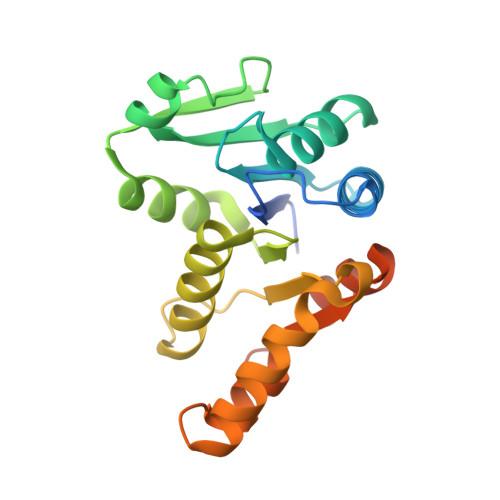Structural basis for cytokinin production by LOG from Corynebacterium glutamicum
Seo, H.-G., Kim, S., Sagong, H.Y., Son, H.F., Jin, K.S., Kim, I.K., Kim, K.J.(2016) Sci Rep 6: 31390-31390
- PubMed: 27507425
- DOI: https://doi.org/10.1038/srep31390
- Primary Citation of Related Structures:
5ITS - PubMed Abstract:
"Lonely guy" (LOG) has been identified as a cytokinin-producing enzyme in plants and plant-interacting fungi. The gene product of Cg2612 from the soil-dwelling bacterium Corynebacterium glutamicum was annotated as an LDC. However, the facts that C. glutamicum lacks an LDC and Cg2612 has high amino acid similarity with LOG proteins suggest that Cg2612 is possibly an LOG protein. To investigate the function of Cg2612, we determined its crystal structure at a resolution of 2.3 Å. Cg2612 functions as a dimer and shows an overall structure similar to other known LOGs, such as LOGs from Arabidopsis thaliana (AtLOG), Claviceps purpurea (CpLOG), and Mycobacterium marinum (MmLOG). Cg2612 also contains a "PGGXGTXXE" motif that contributes to the formation of an active site similar to other LOGs. Moreover, biochemical studies on Cg2612 revealed that the protein has phosphoribohydrolase activity but not LDC activity. Based on these structural and biochemical studies, we propose that Cg2612 is not an LDC family enzyme, but instead belongs to the LOG family. In addition, the prenyl-binding site of Cg2612 (CgLOG) comprised residues identical to those seen in AtLOG and CpLOG, albeit dissimilar to those in MmLOG. The work provides structural and functional implications for LOG-like proteins from other microorganisms.
- School of Life Sciences, KNU Creative BioResearch Group, Kyungpook National University, Daegu 702-701, Republic of Korea.
Organizational Affiliation:


















